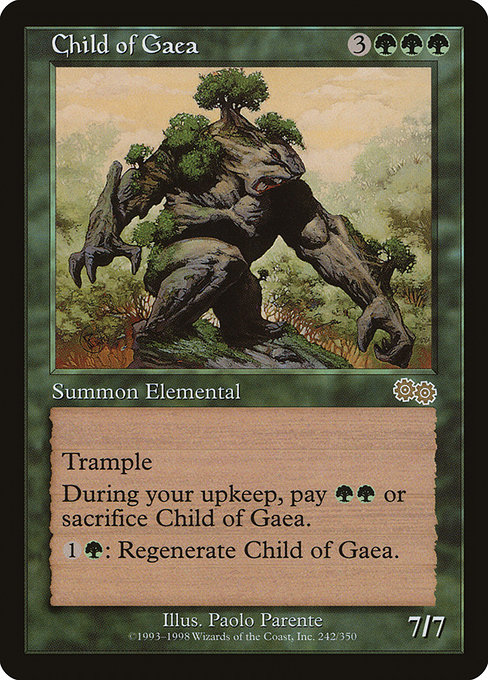
Image courtesy of Scryfall.com
Design consistency across related archetypes
In the grand tapestry of Magic: The Gathering, green archetypes have long marched to a familiar beat: ramp, big bodies, and a respect for nature’s raw, unbridled power. When you scan a card like Child of Gaea, you’re glimpsing a pivot point where design intent and gameplay rhythm converge. This six-mana behemoth—{3}{G}{G}{G} for a 7/7 with trample—embodies the “grow until you overwhelm” ethos that green often leans on. But what makes Child of Gaea such a compelling touchstone for consistency is how its life cycle mirrors the larger green strategy: you invest to accelerate, you sunburst into a formidable battlefield presence, and you lean on green’s resilience to outlast opponents. 🧙♂️🔥
Urza’s Saga, the set that birthed Child of Gaea, sits at a moment in time when designers were crystallizing evergreen themes: the push toward big, decisive threats that feel ancient and elemental. The card’s upkeep mechanic—the requirement to pay {G}{G} to keep it around—reads like a reminder that raw power isn’t free in a world of mana-denial and removal. You’re not simply playing a creature; you’re managing a long-term resource engine. It’s a design pattern fans recognize across related archetypes: ramp-driven giants, mana-saturated finishers, and the stubborn persistence that green so often champions. The option to pay {1}{G} to regenerate adds a layer of strategic depth, transforming a raw stat line into a survivable threat that demands removal spells and careful timing. ⚔️🎨
Character and mechanics in service of theme
Child of Gaea isn’t just a number on a card; it’s a creature whose text reinforces green’s identity. Trample signals inevitability—when this behemoth lands, it breaks through defenses and pushes levers of tempo in your favor. The upkeep sacrifice mechanic is a nod to ecological balance: nature requires maintenance, and neglect comes with consequences. In a broader sense, this mirrors how green archetypes manage resources—by ramping into overwhelming power, then leveraging that power strategically rather than simply “going bigger.” The regeneration option, affordable at {1}{G}, provides a lifeline against aggressive removal and mass bounce, embodying green’s stubborn endurance. It’s a design compact that, over time, has influenced newer green threats and ramp packages that prize staying power as much as raw power. 🧙♂️🔥
From an art and lore perspective, Child of Gaea draws on the primal energy of the forest and earth. The illustrator Paolo Parente brings a sense of ancient, forest-born authority to the scene, a reminder that in UsG’s world, nature isn’t a background—it's a coauthor of every battlefield moment. The card’s presence in paper and early MTGO environments marks green as the color of enduring, ecosystem-wide impact. Thematically, this aligns with later green staples that celebrate “growth beyond the baseline” while rewarding patient investment in the battlefield—a consistent throughline for green’s archetypes across eras. 🧩💎
Practical takeaways for modern decks
For contemporary players building green-centric strategies—whether in Commander’s creature-swarm world or in classic stompy lists—the lesson from Child of Gaea remains: invest, survive, then dominate. Here are a few takeaways you can weave into your game plan today:
- Mana ramp matters as a precursor to inevitability. Child of Gaea demands a robust mana base to reach its stage of dominance. In present-day green shells, you’ll want accelerants and dual lands that smooth the path to six mana and beyond. The payoff is a threat that can overwhelm even well-constructed defenses.
- Reinforce resilience with regeneration and protection. The regeneration option isn’t just flavor—it’s a design invitation to pair such creatures with protective spells or a field that punishes removal. In practice, you tilt toward green cards that protect your big threats or refill their stay power through recursion and redundancy.
- Expect tempo if you ignore the upkeep cost. The sacrifice clause at upkeep creates a natural rhythm: you either pay early and keep control swinging your way, or you plan a re-cast, re-ramp moment. Good green archetypes balance these moments with draw engines, tutors, or defensive lines so you can sustain pressure beyond a single turn.
- Leverage trample to push damage through crowded boards. Trample is green’s way of turning force into inevitability. Even if the board is crowded, a well-timed 7/7 with trample can force game-ending damage and compel opponents to answer threats they’d rather ignore. 🛡️
- Texture the archetype with art and lore to deepen player engagement. The evocative image and the rarity identity of Child of Gaea reinforce green’s archetypal aura: ancient power, patient growth, and nature’s relentless momentum. That flavor helps players connect across formats—from draft to Commander to cube builds. 🎨
As you curate a green archetype—whether you’re chasing a classic “green stompy” feel or a modern ramp-and-finisher plan—keep a steady hand on the mana lever, respect the upkeep cost, and design around a recurring threat that demands instant attention. Green’s consistency across archetypes isn’t about sameness; it’s about a shared promise: growth that compounds, resilience that endures, and victory that arrives with a thundering, leafy flourish. 💚
Custom Gaming Mouse Pad 9x7in Neoprene Stitched Edges